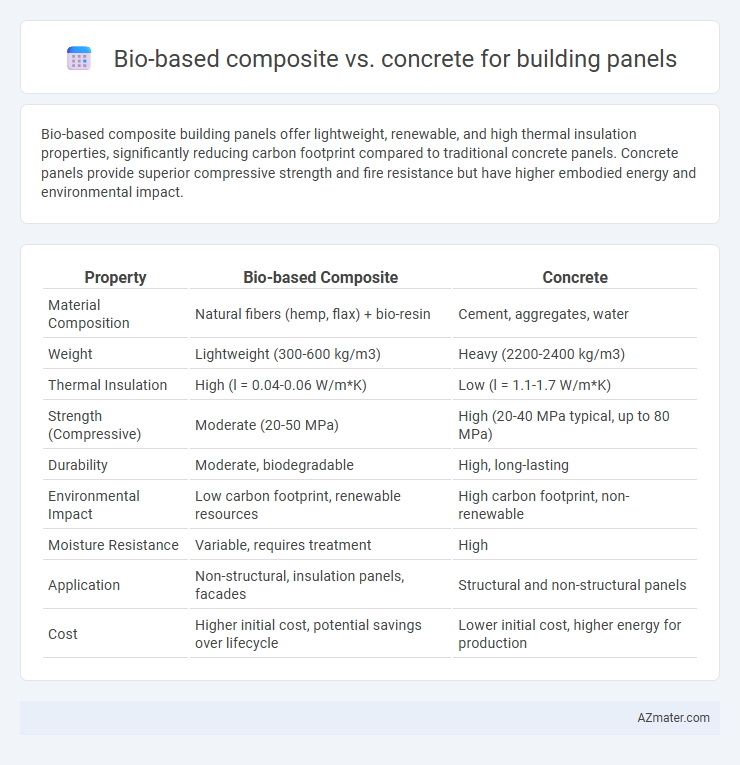Bio-based composite building panels offer lightweight, renewable, and high thermal insulation properties, significantly reducing carbon footprint compared to traditional concrete panels. Concrete panels provide superior compressive strength and fire resistance but have higher embodied energy and environmental impact.
Table of Comparison
| Property | Bio-based Composite | Concrete |
|---|---|---|
| Material Composition | Natural fibers (hemp, flax) + bio-resin | Cement, aggregates, water |
| Weight | Lightweight (300-600 kg/m3) | Heavy (2200-2400 kg/m3) |
| Thermal Insulation | High (l = 0.04-0.06 W/m*K) | Low (l = 1.1-1.7 W/m*K) |
| Strength (Compressive) | Moderate (20-50 MPa) | High (20-40 MPa typical, up to 80 MPa) |
| Durability | Moderate, biodegradable | High, long-lasting |
| Environmental Impact | Low carbon footprint, renewable resources | High carbon footprint, non-renewable |
| Moisture Resistance | Variable, requires treatment | High |
| Application | Non-structural, insulation panels, facades | Structural and non-structural panels |
| Cost | Higher initial cost, potential savings over lifecycle | Lower initial cost, higher energy for production |
Introduction to Bio-based Composites and Concrete
Bio-based composites are engineered materials consisting of natural fibers such as hemp, flax, or jute embedded in a polymer matrix, offering lightweight, sustainable alternatives to traditional construction materials. Concrete, a widely used building material, is composed of cement, aggregates, and water, known for its high compressive strength and durability in structural applications. Advances in bio-based composites emphasize environmental benefits like carbon sequestration and reduced embodied energy, contrasting with concrete's significant carbon footprint despite its structural advantages.
Material Composition and Source Sustainability
Bio-based composites for building panels consist primarily of natural fibers such as hemp, flax, or jute embedded in a biodegradable resin matrix, significantly reducing reliance on fossil fuels compared to traditional concrete. Concrete panels are composed of cement, aggregates, and water, with cement production accounting for approximately 8% of global CO2 emissions, posing sustainability challenges. The renewable nature of bio-based composites and their lower embodied energy contribute to improved environmental performance and reduced carbon footprint in sustainable construction.
Mechanical Properties Comparison
Bio-based composites exhibit superior tensile strength and flexibility compared to traditional concrete, making them more resistant to cracking under stress. While concrete offers higher compressive strength, bio-based composites provide enhanced impact resistance and better durability under dynamic loads. The lightweight nature of bio-based composites also contributes to improved seismic performance and easier handling during construction.
Environmental Impact and Carbon Footprint
Bio-based composites offer a significantly lower carbon footprint compared to traditional concrete, as they utilize renewable natural fibers like hemp or flax, which sequester carbon during growth. Concrete production is highly energy-intensive, responsible for approximately 8% of global CO2 emissions, whereas bio-based panels reduce greenhouse gas emissions through carbon storage and reduced reliance on cement. Life cycle assessments highlight bio-composites' potential to minimize environmental impact by improving biodegradability and decreasing embodied energy in construction materials.
Thermal and Acoustic Insulation Performance
Bio-based composites exhibit superior thermal insulation properties compared to concrete due to their lower thermal conductivity, effectively reducing heat transfer in building panels. Acoustic insulation performance of bio-based composites also surpasses concrete by enhancing sound absorption and dampening capabilities, which minimizes noise transmission. These advantages make bio-based composites a preferred choice for sustainable construction targeting energy efficiency and occupant comfort.
Durability and Lifespan of Building Panels
Bio-based composite building panels offer enhanced durability through resistance to moisture, pests, and chemical degradation, contributing to a lifespan of 25 to 50 years with proper maintenance. Concrete panels typically provide a longer lifespan exceeding 50 years, benefiting from high compressive strength and fire resistance but may suffer from cracking and spalling over time. Advances in bio-based composites, such as improved fiber treatments and resin formulations, are closing the durability gap while providing sustainable alternatives to traditional concrete panels.
Cost Analysis and Economic Viability
Bio-based composite building panels typically offer lower embodied energy and reduced material costs compared to conventional concrete panels, driven by renewable raw materials like hemp, flax, or wood fibers. While initial manufacturing expenses for bio-composites can vary based on processing technology and scale, their lightweight nature reduces transportation and installation costs, enhancing overall economic viability. Concrete panels generally incur higher costs due to raw material extraction, energy-intensive curing processes, and heavier weight, but their durability and fire resistance may offset expenses in long-term structural applications.
Design Flexibility and Aesthetic Options
Bio-based composites for building panels offer superior design flexibility with their lightweight nature and moldable properties, enabling complex shapes, curves, and customized textures that concrete cannot easily achieve. These composites allow a broader range of aesthetic options, including natural finishes, vibrant colors, and varied surface patterns, enhancing architectural creativity and visual appeal. Concrete panels tend to be rigid and limited in form, often requiring additional treatments or coatings to achieve diverse aesthetics, which can increase costs and processing time.
Regulatory Standards and Certifications
Bio-based composite building panels must comply with sustainability certifications such as FSC, LEED, and BREEAM, which emphasize environmental impact, carbon footprint, and indoor air quality. Concrete panels are regulated under standards like ASTM C1598 and EN 15037-1, focusing on structural strength, fire resistance, and durability. Both materials require compliance with local building codes, but bio-based composites often face stricter scrutiny regarding biodegradability and moisture resistance to meet safety certifications.
Future Trends in Building Panel Materials
Bio-based composites are gaining traction due to their renewable raw materials, biodegradability, and superior thermal insulation properties compared to traditional concrete. Innovations in nanocellulose reinforcement and bio-resin matrices enhance the mechanical strength and durability of bio-based panels, aligning with sustainability goals and reducing carbon footprints. Future trends emphasize integrating smart sensing technologies within bio-composites for real-time structural health monitoring, positioning them as a viable alternative to conventional concrete in building panels.

Infographic: Bio-based composite vs Concrete for Building panel
 azmater.com
azmater.com